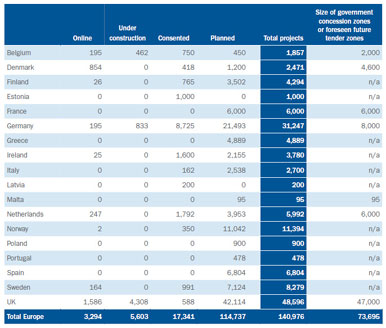Offshore wind will provide 13.1% of Europe’s electricity, powering 130 million homes, if all the projects currently planned go through.
About 141 gigawatts (GW) in 17 EU countries is either built, under construction, consented, or planned in Europe. That’s 35 times the capacity of the 4 GW installed today.
Offshore wind farms with a capacity of 5.6 GW are under construction in the UK, Germany and Belgium.
"There is huge developer interest in offshore wind energy across Europe," says Arthouros Zervos, President of the European Wind Energy Association (EWEA), after publishing a report analyzing all existing offshore wind projects.
The industry is expected to create 169,000 offshore wind jobs by 2020, and 300,000 by 2030, according to the EWEA report.
99% of the world’s installed offshore capacity is off Europe’s coast.
But EWEA warns that investors must supply sufficient financing to fulfill the industry’s potential. Also crucial are financing and building offshore power grids in the northern and Baltic seas, which would enable huge amounts of electricity to be transported to consumers.
Other urgent matters the industry needs to address are a looming shortage in high-voltage subsea cables in the next few years, and a shortage of trained workers.
"The offshore wind energy sector can replicate the success of onshore wind technology development, which is now a mainstream source of power competitive with new coal and gas plants, and a major European industry", says Zervos. "However, to ensure this happens, EU-decision-makers need to set ambitious renewable energy targets beyond 2020, invest more in research and develop the offshore grid."
The UK is forecast to deploy 1.2 gigawatts (GW) a year in offshore wind in 2012, and exceed 2.5 GW in 2016, stressing the wind supply chain’s ability to keep up, according to RenewableUK.
While the UK is cutting back on solar subsidies, it extended them to 2015 for offshore wind, with smaller than expected cuts after that.
Germany’s revised feed-in law also cuts solar subsidies and shifts the emphasis of support to offshore wind and other kinds of renewable energies. The new law resulted in a EUR 1.2 billion private investment for the Meerwind offshore farm and its North Coast is experiencing a "gold rush."
Wind energy accounts for the majority of the world’s non-hydropower renewable electricity capacity. Even with the global economic slowdown affecting the sector in 2010, the industry will grow to a $153 billion global powerhouse by 2017, up from $77 billion in 2011, according to Pike Research.
Over this period, installations will increase from 235.8 GW in 2011 to 562.9 GW, representing a staggering cumulative investment of $820 billion.
Wind supplies 21% of electricity in Denmark, 18% in Portugal, 16% in Spain, 14% in Ireland and 9% in Germany as of 2010.
Here’s a table of the offshore projects planned for each EU country.

Here’s the report, Wind in our Sails:

